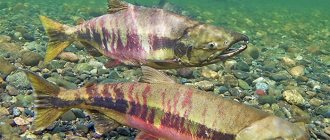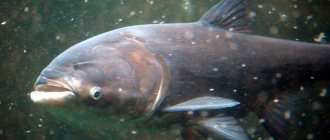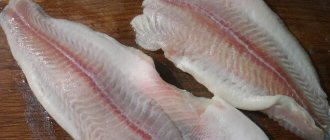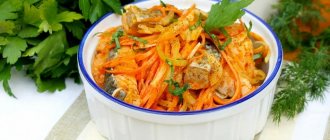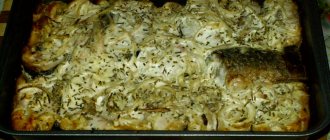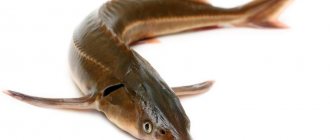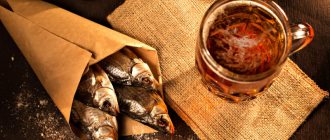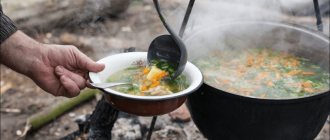Created: 05/23/2019
Updated: 01/29/2021 13:30:46Share:
Red fish is not only a delicacy, but also a very healthy product. It contains a huge amount of vitamins, fatty acids, microelements and other important nutrients. However, “red fish” is a common name for a huge number of salmon varieties.
Thus, “red fish” can be called salmon, pink salmon, sockeye salmon, salmon, chum salmon, trout and many other varieties. And they differ quite a lot from each other. Apart from chum salmon and pink salmon, they are very similar and often “replace” each other on store shelves.
Therefore, housewives may have a reasonable question: “Which is better and healthier – chum salmon or pink salmon?” Let's look into this material.
Taste
Despite the similarities, different varieties of red fish have different characteristics, biochemical composition, nutritional value and quality. The pulp varies:
- fat content;
- tenderness of muscle fibers;
- more delicate or, conversely, pronounced taste qualities;
- composition of valuable elements - Omega-3 fatty acids, amino acids, minerals, vitamins.
Therefore, in order to make the right purchase, let’s consider the difference between the highest quality representatives of red fish species, which are these 2 varieties of salmon.
Speaking of taste, it is worth noting the following features of the meat of these two types of salmon:
- Chum salmon has several subspecies, but despite this, its taste, quality and other characteristics remain almost identical. The meat of this fish has a slightly grayish tint, that is, it lacks that bright red color that the consumer is accustomed to seeing in other salmon species. Protein fibers are dry. Therefore, it is best to salt this fish, just like pink salmon. It is in this form that it tastes best.
- Coho salmon has more tender meat that is suitable for different cooking methods. This species of fish does not breed in captivity. Therefore, it does not have artificial antibiotics and other harmful components that accumulate in meat during artificial cultivation. This is a delicious fish with a slight bitter taste.
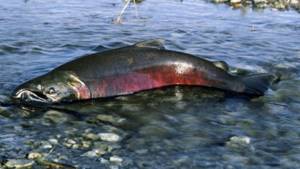
Taste and use in cooking
Nutritionally, chum salmon has a lower fat content than other salmon, giving it a softer, more delicate taste without losing beneficial acids and other trace elements such as selenium and niacin. Its low fat content and milder taste make it suitable for those who do not like the more pronounced flavor of other salmon. At the same time, chum salmon is tasty enough to be used in many culinary recipes.

Important! The duration of heat treatment of chum salmon depends on the thickness of the pieces. Every 1.5 cm is 4-5 minutes of frying, stewing or baking.
Culinary profile of chum salmon:
- meat:
- light pink or orange;
- texture: dense, rougher than salmon;
- taste: mild;
- Application: can be baked, fried, grilled and deep-fried; fillet accounts for: 70% of the weight of the fish;
- available for catching: from July to November.
To maximize the quality and quantity of eggs, chum salmon are caught later in their life cycle, during the spawning phase. At this time, the meat becomes softer and less flavorful. In the phase when the fish is in the ocean, its flesh is of high quality and its appearance is indistinguishable from salmon.
Chum salmon is the most numerous and valuable fish of the northern regions. It lives in small schools in the upper layers of water, where there are many crustaceans and small fish - its main food. Thanks to good nutrition, adult individuals gain weight of about 5 kg and acquire excellent taste, which allows them to count on a place in your diet.
Which one is fatter?
Comparing the fat content of both fish, the difference is not significant:
- Thus, chum salmon contains about 5.6 g of unsaturated fatty acids for every 100 g of muscle fiber weight.
- Coho salmon. It is very difficult to distinguish 2 fish by this parameter, since when fresh it contains 5.93 g of unsaturated fatty acids.
But still, from a comparison of this parameter, chum salmon is drier, which requires taking this parameter into account during cooking. Therefore, if you want fattier fish, which will be cooked on coals, on the grill, in the oven, then coho salmon will turn out to be tastier due to the fact that it is fattier. But the difference is still insignificant.
Useful information
Chum salmon meat and caviar contain the substance thiamine, which can protect the human body from the harmful toxins of alcohol. If you are going to drink alcohol, then, if possible, order a dish of this fish.
For cosmetic masks, never buy chum salmon caviar in stores or supermarkets, as it is often sold with a lot of salt.

It is still unclear to scientists exactly how chum salmon can find the river in which it was born, but this is a fact: the fish spawns in its “native place” and only once in its life. There is a version that it has very sensitive olfactory organs and is capable of capturing the smallest nuances, by which it determines the composition of water.
Chum skin is used to make souvenirs and even shoes. We are talking about fish during spawning - only in this case does its skin become dark, rough and suitable for making products.
See also: Fish diet
Differences in KBZHU
It is interesting to compare chum salmon and coho salmon in terms of calorie content and nutritional value.
The KBJU of chum salmon is:
- Calorie content – 127 kcal.
- Proteins – 19 g.
- Fats – 5.6 g.
- Carbohydrates – 0 g.
KBZHU for coho salmon are in the following range:
- Calorie content – 140 kcal.
- Proteins – 21.6 g.
- Fats – 6 g.
- Carbohydrates – 0 g.
Comparing these parameters, it is worth noting that due to the smaller amount of fat in chum salmon, it becomes drier. It also differs in that it contains less protein compared to coho salmon.
Which red fish caviar is better and what are the differences between the varieties?
Not all caviar connoisseurs are aware of how many varieties exist in nature. And, of course, they all differ in the type of “carrier”, which means spawning fish. And yes, it is worth recalling once again that salmon is not a fish, but a conventional name for all species from the family Salmonidae, of which there are many.
Chum salmon
One of the most delicious types of caviar is chum salmon.
The distinctive characteristics of this variety are a fairly large size, often reaching 6 mm in diameter, an amber-orange color with a visually pronounced germ spot and a dense shell, due to which not all lovers choose chum caviar, although it is not inferior in taste none of the others.
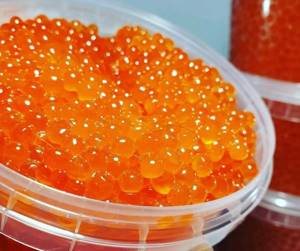
Chum salmon caviar is large, rich orange in color. It tastes better than any other salmon caviar
Pink salmon
Perhaps one of the most common types of caviar with a pleasant, closer to neutral, taste, medium size, most often not exceeding 5 mm, and a rich orange color. It is noteworthy that the shell of this variety is less dense, which, on the one hand, adds points to it, and on the other hand, promotes the formation of juice (flowing from the contents of the burst eggs).
The wide distribution of this delicious product is due to the fact that pink salmon is rightfully considered the most prolific fish in the family.
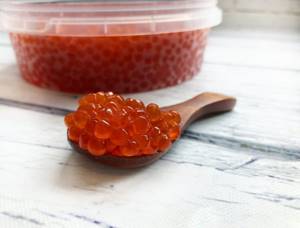
Pink salmon caviar is less dense, which is both good and bad at the same time. On the one hand, it is softer, but on the other, more fragile, which is why the eggs burst and form juice
Sockeye Salmon
When you see fine-grained caviar of a bright red color, you should not rush to conclusions, suspecting a fake, because, most likely, this is a product obtained from sockeye salmon. By the way, this is one of the rarest guests on the Russian market, since this cold-water fish of valuable species is found mainly off the coast of Alaska and its import into Russian territory is punishable by law, being officially prohibited.
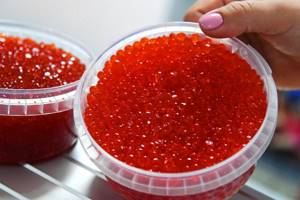
Sockeye salmon caviar is a rare guest on the Russian market. Its distinctive characteristics are its rich red color and small caliber
Coho salmon
This variety of salmon also has very good caviar - it is quite small (up to 4 mm), rich red (closer to burgundy) in color and has a noticeable piquant bitterness. At the same time, this type is the most useful, nutritious, and therefore in demand among experts.
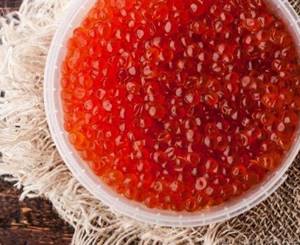
Coho salmon caviar is small, rich ruby color, with a slight bitterness. But its main advantage is not its taste, although that is also good, but its composition, which is rightfully considered the most useful
Trout
The most budgetary, but no less interesting option. The size of the eggs is very small - each is only a couple of millimeters in diameter, and such caviar comes in two colors - yellow and rich ruby. Among other features is a specific bitterness in taste, although this circumstance does not particularly spoil the product, which invariably has many admirers.

Trout caviar is good in its own way. And despite its inherent bitterness, many connoisseurs prefer this particular type
Main differences
Comparing chum salmon and coho salmon, we can highlight the following parameters by which these 2 types of fish differ:
- Coho salmon is higher in calories due to its higher fat content.
- If you want to get more proteins, then buy coho salmon.
- Both fish are large in size; small specimens are extremely rare. But finding coho salmon or sockeye salmon weighing more than 14 kg on sale is also very difficult. Chum salmon is most often sold as a whole carcass and weighs about 4-5 kg. Coho salmon are slightly larger, about 5-7 kg.
- Considering the prevalence, it is chum salmon that has the largest one, since its fishing is much wider, and it is also grown in artificial conditions.
- Coho salmon is a fish that is not raised in cages, just like sockeye salmon. It is caught exclusively in the wild, so it is better than all other types of salmon - salmon, which are grown industrially. After all, it is this parameter that allows you to be confident in the environmental friendliness of the fish. Coho salmon, like sockeye salmon, are fish highly valued by gourmets due to their nutritious meat or rich mineral composition. They have a slight piquant bitterness.
- The price of coho salmon is higher than that of chum salmon. This is due to the population and distribution area of the fish.
But, despite this difference, everyone will choose the most suitable fish for themselves, both in terms of taste and a number of other characteristics.
Differences between coho salmon and sockeye salmon
Coho salmon is one of the largest representatives of the Salmon family. It lives in the waters of the Pacific Ocean. Its weight can reach 15 kg. Other characteristics:
- The body is elongated, grows up to 1 meters.
- The scales of coho salmon are light and quite bright.
- The head is massive, the mouth is especially noteworthy.
- Forehead raised high.
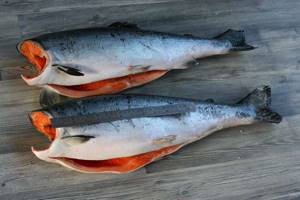
Moving in the water, this fish shimmers with all the colors of the rainbow due to its numerous bright scales. The upper part of the head is green with a bluish tint. There are black spots of irregular shape on both sides of the body.
Sockeye salmon is also a representative of Salmonidae , but its weight is less. It does not exceed 3.5 kg. The body length also rarely reaches more than 80 cm. In appearance, sockeye salmon resembles chum salmon. However, the latter has a large number of stamens on its gills, which is not found in sockeye salmon.
Difference from pink salmon
If you compare chum or coho salmon with pink salmon, the following facts become obvious:
- Pink salmon has the driest meat of all salmon species, despite almost the same content of proteins, fats and calories. Thus, pink salmon contains 20.5 g of protein for every 100 g of meat weight. Fat - 6.5 g, and calories - 140 kcal, like coho salmon.
- Pink salmon is a common fish in terms of habitat. Therefore, its price is lower compared to other types of red fish - coho salmon, chum salmon or sockeye salmon.
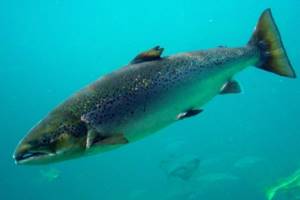
Contraindications and harm from fish
Excessive consumption of chum salmon, especially in salted and smoked form, is fraught with undesirable consequences. The recommended dose of chum salmon consumption per day is 100-150 g; eating fish 3 times a week is enough.
Contraindications to the use of smoked and salted products:
- gout;
- disturbances in the functioning of the pancreas;
- kidney disease;
- heart diseases.
Abuse of the product in any form can lead to disturbances in the gastrointestinal tract, namely, indigestion, nausea, bloating and constipation.
Salted fish and caviar contain a lot of salt, which retains fluid in the body and leads to swelling. Milk is not recommended for people with eating disorders and obesity.
In addition, chum salmon, like any other seafood, accumulates heavy metals in the meat. Therefore, excessive consumption of fish can lead to mercury poisoning.
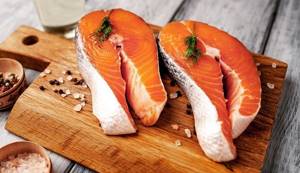
© Alexander Talantsev — stock.adobe.com
What is more suitable for pickling
When choosing what is best to salt, it is still better to choose chum salmon.
This is due to the fact that it contains a lot of water and a little fat. In addition, the structure of the protein is such that during heat treatment it becomes excessively dry and hard. Therefore, it is always better to salt this fish. This way the meat turns out tender, quite juicy and retains its consistency and structure. In addition, the pieces remain intact when cut.
But coho salmon is also tasty when salted. The only thing that needs to be taken into account is the need to add more salt than when preparing chum salmon. This is due to the fact that fatty fibers absorb salt less readily.
Here it makes sense to say that when choosing a cooking method, it is still better not to heat treat chum salmon. It will taste best when salted. But coho salmon can be baked, salted or fried. It will be equally good in any form. Therefore, the choice depends on preference.
How to salt at home
To prevent the fish from turning out to be dry, for home salting it is better to take whole, ungutted carcasses and cut them yourself.
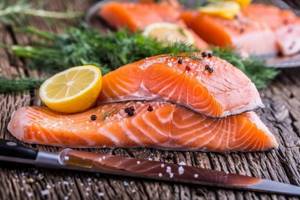
Not all spices are suitable for red fish. Use spices that will enhance the taste of the product:
- mustard seeds;
- Bay leaf;
- rosemary;
- nutmeg;
- dry parsley;
- thyme;
- caraway;
- cloves;
- whole coriander;
- allspice peas.
To avoid oversalting the fillet, use medium or coarse salt.
Fast way
If cooking time is limited, this salting method will help out any housewife.
You will need:
- fillet – 1 kg;
- sugar – 2 tbsp;
- salt – 2 tbsp;
- lemon juice – 5 tbsp;
- allspice – 7 pcs.;
- bay leaf – 2 pcs.
Preparation:
- We wash the boneless fillet and cut it into strips 0.7-1 cm thick.
- Mix salt, sugar, spices.
- Dip the pieces in the resulting mixture and place them in layers in a bowl.
- Sprinkle each layer with lemon juice.
- Cover with a plate, put on the press and leave for 40 minutes at room temperature.
- Remove the remaining seasonings and salt and serve.
Spicy Ambassador
You will need:
- chum salmon – 1 kg;
- olive oil – 2 tbsp;
- salt – 2 tbsp;
- sugar – 1 tbsp;
- garlic – 3 cloves;
- cloves – 4-5 pcs.;
- bay leaf – 2 pcs.
Preparation:
- Cut the chum salmon into pieces 1.5-2 cm thick.
- We cut the garlic into slices and stuff it into the fish.
- Mix sugar and salt and rub each piece.
- Place tightly in a deep container, sprinkle with spices.
- Drizzle with olive oil and cover with a lid or a plate of smaller diameter than the dish with fish.
- Place the weight on top. A water bottle will do.
- Leave for 1 hour, then remove the weight and mix the fillets.
- Cover with a lid and place in the refrigerator for 1.5 hours.
Nutritional value and calorie content
Almost 3/4 of chum salmon fillet consists of water, and a fifth of the product consists of high-quality proteins. The calorie content of this fish is not the lowest - approximately 126 kcal, but with moderate consumption this will not affect the figure in any way. Moreover, the fats that make up the fillet are very beneficial for the body. In terms of the amount of proteins (and with them essential amino acids), the meat of this type of salmon is often compared to chicken.
In addition, chum salmon is a source of methionine, an important amino acid that cannot be obtained from meat products. By the way, many nutritionists consider proteins from fish to be more beneficial for humans than meat proteins. One of the reasons is called digestion time. If, say, the human digestive system takes at least 5 hours to process veal, then it will take about 120 minutes to break down chum salmon and extract useful elements from it.

Almost 3/4 of chum salmon fillet consists of water, and a fifth of the product consists of high-quality proteins. The calorie content of this fish is not the lowest - approximately 126 kcal, but with moderate consumption this will not affect the figure in any way. Moreover, the fats that make up the fillet are very beneficial for the body. In terms of the amount of proteins (and with them essential amino acids), the meat of this type of salmon is often compared to chicken.
In addition, chum salmon is a source of methionine, an important substance that cannot be obtained from meat products. By the way, many nutritionists consider proteins from fish to be more beneficial for humans than meat proteins. One of the reasons is called digestion time. If, say, the human digestive system takes at least 5 hours to process veal, then it will take about 120 minutes to break down chum salmon and extract useful elements from it.
This Pacific fish contains almost all the components necessary for active life: almost the entire complex of B vitamins, vitamins A and E, important and. Biochemists have determined that 100 g of chum salmon is:
- 22 mg;
- 330 mg;
- 205 mg;
- 65 mg;
- 0.5 mg;
- 35 mg;
- 430 mg;
- 0.8 mg;
- 0.4 mg;
- 1.5 mg;
- 1.3 mg;
- 1.3 mg;
- 2.3 mg.
In red fish meat, the most valuable element is fat. According to this indicator, the leading position is occupied by salmon. Chum salmon is drier and has less calories.
| Contents per serving | Salmon | Chum salmon |
| calories | 153 | 127 |
| squirrels | 20 | 19 |
| fats | 8,1 | 5,6 |
| carbohydrates | 0 | 0 |
| alimentary fiber | 0 | 0 |
| water | 71 | 74 |
